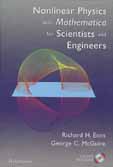 |
Nonlinear Physics with Mathematica for
Scientists and Engineers
Richard H. Enns and George C. McGuire, Birkhauser Verlag AG, Basel
etc. (2001) , price ca. € 70.- |
 |
Nonlinear Physics with Maple for Scientists and Engineers,
2nd ed.
Richard H. Enns and George C. McGuire, Birkhauser Verlag AG (2001),
Basel etc., price ca. € 70.- |
 |
Dynamical Systems with Applications using Maple
Stephen Lynch, Birkhauser Verlag AG, Basel etc. (2001), price ca. €
65.- |
| Reviewer: Alois Steindl, Institute for Mechanics,
Vienna University of Technology. |
Level: medium.
During the last decades symbolic algebra packages have become a
powerful mathematical tool. Programs like Mathematica or Maple provide
sophisticated symbolic, numeric and graphical capabilities, which are
very useful for the investigation of mathematical problems. It is
especially convenient to formulate a set of equations within one
program and let this program perform simulations, visualize the
results, apply transformations or series expansions, just to name some
important tasks for applications.
The books ``Nonlinear Physics with Mathematica for
Scientists and Engineers'' and ``Nonlinear Physics with Maple for
Scientists and Engineers'' by Richard H. Enns and George C. McGuire
and ``Dynamical Systems with Applications using Maple'' by Stephen
Lynch demonstrate how to treat simple and difficult systems arising in
different branches of Applied Mathematics using the dominant computer
algebra systems Mathematica and Maple.
Dynamical Systems with Applications using Maple
The paperback by Stephen Lynch concentrates mainly on continuous and
discrete dynamical systems. After a short introduction into Maple
simple ordinary differential equations are considered. The student
learns to study the behaviour of (essentially) planar differential
equations by drawing the vector fields and phase portraits. Also the
linearization of the vector field at critical points and the
Poincaré-Bendixson theorems are explained very well.
Further chapters deal with Hamiltonian systems, Lyapunov functions and
bifurcation theory. It is shown how the dynamics of the system
changes at a bifurcation point and that hysteresis effects are
possible for certain parameter combinations.
In this chapter I would expect to find a short explanation of Center
Manifold theory and Normal Form simplification, because these tools
are essential for higher dimensional systems and can benefit quite a
lot from algebra systems.
The chapters on Hilbert's sixteenth problem and limit cycles of
Liénard systems demonstrate nicely how the graphical, symbolic and
numeric capabilities of Maple can be used to deal with mathematical
problems.
The following chapters cover discrete dynamical systems, complex
iterative maps and fractals. As main application optical resonators
are introduced in some detail and some rather complicated bifurcation
diagrams for these devices are shown.
Finally the concept of ``controlling chaos'' is introduced and applied
to several chaotic systems.
A student or scientist, who works through some chapters of the book,
learns a good deal about the presented mathematical concepts and
possibilities of the symbolic algebra package to assist the researcher
in understanding his mathematical model.
Nonlinear Physics with Mathematica for Scientists and Engineers
and Nonlinear Physics with Maple for Scientists and
Engineers
Also the authors of these voluminous hardcover books emphasize that
their main subject are the basic concepts and applied mathematical
methods of nonlinear science. Additionally the second part of the
books describes a series of experimental activities, which the
reader/student should carry out to watch interesting phenomena, that
can be understood with the theoretical background from the first part.
The books also contain CD-ROM media with the Maple worksheets or
Mathematica notebooks to run the examples from the books and play
around with the system.
After a short introduction (with many carefully selected examples) to
the packages the books start with rather simple dynamical systems,
e.g. from mechanics, population dynamics, and chemical reactions.
Then specific topics for nonlinear systems, like pattern formation,
solitons and chaos are introduced and presented very clearly.
After this exposition topological methods like phase plane analysis
and linearization are applied to several dynamical systems. Then the
authors present several exact and approximative analytical methods to
deal with nonlinearities. For these calculations the symbolic abilities
of the programs are indispensable.
Chapter 6 discusses several numerical methods to integrate `normal'
and stiff ODEs.
Chapter 7 is devoted to (self-excited) limit cycles; while the
Poincaré-Bendixson
theory is explained with sufficient detail, the Hopf bifurcation
theorem, which also applies to higher order systems, isn't mentioned
in this part. Next various aspects of forced oscillations and
nonlinear maps are treated.
The following chapters are devoted to the analytic and numeric
treatment of nonlinear PDEs, especially methods to calculate solitary
waves.
Also these two books cover a large range of topics from simple
differential equations to nonlinear PDEs. In addition to the presented
theory many problems are stated as exercises to help the student to
consolidate his new knowledge. Furthermore the provided programs for
Mathematica and Maple demonstrate how to delegate the nasty
calculations to computer programs and how to obtain reliable numerical results
and impressive graphic output.
All three books demonstrate that it is quite straightforward to
calculate stable solutions, which can also be observed in
experiments. Unfortunately it isn't that easy to calculate unstable
solution branches, which might also play an essential role for
nonlinear systems, because they sometimes delimit domains of
attraction or lead to `crises', that govern the periodic windows
within chaotic regimes. I would have appreciated some discussion about
the role of these unstable solutions and maybe some pointers to
numerical or symbolic packages for their determination.
Nevertheless I recommend these three books as excellent textbooks for
dynamical systems and good explanations how to apply (the most common)
computer algebra packages for the analytical and numerical treatment
and graphical representation of the mathematical models.